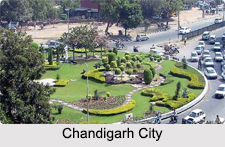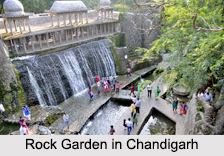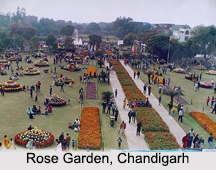 Chandigarh is the richest city and an early planned city located in the northern part of India. This city is known for modern Indian art and architectures. The urban designs of the building will allure the eyes most.
Chandigarh is the richest city and an early planned city located in the northern part of India. This city is known for modern Indian art and architectures. The urban designs of the building will allure the eyes most.
Origin of name -Chandigarh
The name of Chandigarh was obtained from Chandi Temple, which was located at the site were the city is now located. The deity of this temple was `Chandi`, the goddess of power and there was a fort beyond the temple, known as `garh`. Thus the name of the Chandigarh was partly derived from the name of the deity of the temple `Chandi` and the fort `garh`. Thus, the name Chandigarh was evolved and the meaning of Chandigarh means fort of the goddess of strength.
History of Chandigarh
The city of Chandigarh has its trace from pre historical era. For the presence of water bodies, this city became the centre of trade in Harappan era. In 1947, the British India was partitioned into India and Pakistan. Unfortunately, the region of Punjab was also split between India and Pakistan. Then there was a need for a new capital for Punjab, as the old capital `Lahore` became part of Pakistan during the Partition of India. Of all the town schemes put forward, Chandigarh project quickly assumed prime significance because of Jawaharlal Nehru`s personal interest in it. In 1948, under the leadership of chief architect Mr. P.L. Verma the construction of this capital city began. Chandigarh became a Union territory then.
Geography of Chandigarh
Chandigarh is located in the Northern part of India. It is located in between Punjab and Haryana and shares its borders with Haryana in the south and Punjab in the north. It covers an area of approximately 114 square kilometers. Chandigarh is located near to the foothills of the Shivalik range of Himalayas in Northwest India. The exact cartographic co-ordinates of Chandigarh are 30.74 degree north to 76.79 degree east. It has an average elevation of 321 metres. The surrounding districts are of Mohali District and Ropar District in Punjab and Panchkula District in Haryana. The boundary of Himachal Pradesh is not too far from its north.
Demography of Chandigarh
 According to the Population census in the year 2011, Chandigarh has the population of about 1,055,450. The males in Chandigarh constitute 55 percent of the population and females constitute 45 percent. The major religious groups are Hinduism, Sikhism, Islam, and Christianity. Hindus constitute about 75.5 percent, Sikhs about 21 percent, Muslims about 2.72 percent and Christians about 0.78 percent of the population. The major languages spoken by the people are Hindi and Punjabi.
According to the Population census in the year 2011, Chandigarh has the population of about 1,055,450. The males in Chandigarh constitute 55 percent of the population and females constitute 45 percent. The major religious groups are Hinduism, Sikhism, Islam, and Christianity. Hindus constitute about 75.5 percent, Sikhs about 21 percent, Muslims about 2.72 percent and Christians about 0.78 percent of the population. The major languages spoken by the people are Hindi and Punjabi.
Culture of Chandigarh
Chandigarh shares urban cultures of Delhi, Haryana and Punjab. The cuisines here are popular too. Chandigarh celebrates the Hindu, Muslim and the Sikh festivals. The Cactus Show, Baisakhi, Mango Festival, Teej Festival and Chandigarh Carnival are popular regional festivals of Chandigarh. The people of Chandigarh are interested in sports like hockey, cricket, athletics, football, tennis, and badminton. The people are also interested in adventure sports like paragliding, trekking, boating, rowing, sailing and sculling.
Education of Chandigarh
Chandigarh is keen in providing education to all students irrespective of class, caste, sex, religion or sect. The main educational institutes are Punjab University, Punjab Engineering College and the Government College of Arts. Among the new teaching and research institutions established in Chandigarh in the decade of the 1960s are the Postgraduate Institution of Medical Education and Research and College of Architecture. There are number of specialized institutions have been established here, making the city a base for higher education.
Administration of Chandigarh
The administration of Chandigarh lies in the responsibility of the President of India acting through the administrator. The administrator acts as the Financial Commissioner, thus enjoying the financial powers of the state. The major departments that come under the government section are Industries, Education, Finance, Excise and Taxation, Vigilance, Sports, Animal Husbandry, Health, Social Welfare, Rural Development, Environment, Engineering, Urban Planning, District Administration, Tourism, Transport, Food and Supplier and Housing.
Economy of Chandigarh
The important industries in Chandigarh are paper manufacturing, basic metals and alloys and machinery. There are other industries that are related to food products, sanitary ware, auto parts, machine tools, pharmaceuticals and electrical appliances. The IT Park of Chandigarh is making attempts to break into the IT world. The multinational corporations boom in this city for the employment.
Tourism in Chandigarh
Chandigarh is dotted with many tourism destinations like Capitol Complex, Open Hand Monument, rock garden, Zakir Hussain Rose Garden, Kansal forest, Government Museum and Art Gallery, Museum of Evolution of Life, International Dolls Museum, Hidden Valley and Nepli Forests. Here the amateur adventure tourism is also popular among the weekenders and the tourists.



















